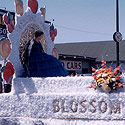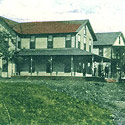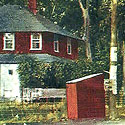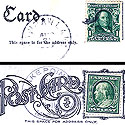The History of Berrien County, Michigan
Click photos below
for expanded views

| 
| 
| 
| 
| 
| 
| 
| 
| 
| 
| 
|
Berrien County has received a wide range of accolades. According to American novelist James Fenimore Cooper, Berrien lies in "a region that almost merits the lofty appellation of the Garden of America." A 1718 French official reported, "Tis a spot, the best adopted of any to be seen, for the purpose of living." And John Harner, one of the county's first settlers, wrote in 1834, "it looks pretty good to me; and others are sure to follow."
Harner was right. Many did follow, and basing its development on a trinity of fruit, tourism and industry, Berrien County has become one of the state's wealthiest and most populated counties.
Located on Lake Michigan in the southwest corner of the state, and bisected by the St. Joseph River, Berrien County has a long history that begins with the earliest explorers of the Great Lakes. Jacques Marquette was the first white man to visit the region. But it was Rene' Robert Cavelier Sieur de la Salle who had the first real impact.
Arriving in 1679, La Salle built Fort Miami at the mouth of the St. Joseph River. Located at the present site of St. Joseph, Ft. Miami became the base for several explorations into the Mississippi River Valley. Near the end of the seventeenth century other French explorers built Ft. St. Joseph up the river at the present site of Niles. They also established a Jesuit mission at the Niles fort.
Though Ft. Miami fell into disuse, Ft. St. Joseph was occupied until the French left the area in 1763. The British held the fort until captured by the Spanish in 1781. Though the Spaniards stayed only a few days, their presence provided Niles with the unique distinction of being a "Town of four flags"; the only Michigan community able to make such a claim.
With the exception of a few traders, Berrien remained unsettled until Squire Isaac Thompson, the county's first settler, arrived at Niles in 1823. Organized in 1831 and named after U.S. Attorney General John M. Berrien, the county was populated by settlers who poured into Berrien during the 1830s and endured a multitude of hardships.
One problem, the "ague," a form of malaria that came on as attacks of violent chills, high fever, and copious sweating, plagued the newcomers throughout the 1830s. But the settlers resolved their problems with ingenuity. One Buchanan housewife rigged up a harness so her husband could churn the butter and rock the baby each time he was afflicted with the "shakes."
During this period Michigan's Indians and settlers maintained a cordial relationship. But in one instance, that cordiality temporarily ended. At the James M. Sorter cabin it was common for Indians to spend severe winter nights before the cabin's fire. But one morning when the Sorters awoke they discovered that their nocturnal guests had stolen part of their precious winter food supply. Disappointed that their trust had been violated, a week later, the Sorters were pleased to find a freshly killed deer on their table as repayment for the missing food.
Pioneers continued to immigrate to Berrien and by the outbreak of the Civil War the county's population stood well over 20,000. Answering their country's call-to-arms, Berrien sent over 3,000 men and a few women to war.
With the advent of war Hannah Carlisle of Buchanan accompanied the 2nd Michigan Cavalry to St. Louis, was assigned as a nurse, and served in that capacity for the duration. Women at home received less publicity but also 'served.' After the war, D. W. Gaugler of Berrien Springs was able to sell his farm and enter the furniture business because, while he was off to war, his wife had managed the farm so efficiently that she greatly increased its value.
Following the war, Berrien experienced impressive growth. As early as 1670 a member of La Salle's expedition wrote that the area's warm winters and sandy soil provided a good place for growing all kinds of fruit.
The French were mainly trappers, not farmers, and did not exploit this opportunity, but it foretold of things to come. As early as 1834 peaches were being harvested and in 1839 the first shipment of peaches was transported and sold in Chicago. From these small beginnings, Berrien County's fruit production has grown to enormous proportions.
Today Berrien is the heart of Michigan's 'fruit belt,' and its fruit production is awesome. The county leads all Michigan counties in the production of peaches, pears and grapes, is second in apples, plums and prunes, and a respectable fourth in tart cherries. Berrien is also the home of Michigan's wine production. Benton Harbor has long been the home of the world's largest outdoor retail fruit market, and every spring a half-century old "blessing of the blossoms" ceremony begins a weeklong celebration, which is culminated by a parade viewed by crowds in excess of 250,000.
Scenes from the 1958 Blossom Parade:
Image 1 / Image 2 / Image 3 / Image 4
The second aspect of Berrien's trinity of growth is tourism. As with the fruit industry, Lake Michigan and the proximity to Chicago greatly aided the county's tourist trade.
In 1873 Stanley Morton, one of Benton Harbor's earliest residents, ran his small ship, the Lake Breeze, to Chicago and transported tourists to southwestern Michigan. By the summer months of the early twentieth century, numerous ships made the short voyage and brought thousands of Chicagoans to Berrien.
Up and down Berrien's fifty-mile coastline, as well as among its eighty-six inland lakes, were resorts, which catered to the tourists' demands. Places like the Whitcomb, Golfmore, Planks Tavern, Paw Paw Lake, and Tabors Farm, were only a few of the many resorts that were jammed every summer. But with the popularity of the automobile, tourists followed highways north and tourism today is more a fond memory than a flourishing industry.
| Paw Paw Lake Sidenote
With the throngs of tourists also came a tremendous need for accommodations. This was certainly the case in the Paw Paw Lake area! One example of the available accommodations was The Naomi -- as seen on a promotional postcard, circa 1907.*
In this view we see the scene at Beechwood Point where many a tourist was able to enjoy not only a night's rest, but a quick swim -- as seen on a promotional postcard, circa 1911.*
These postcards feature both a glimpse into the region's accommodation history and also a little peek into the region's postal history as well. This Postal History includes a "'PawPaw' Lake" postmark dated August 31, 1907 and a "Lake Point" postmark dated July 17, 1911.
The 'PawPaw' Lake Post Office was a "Summer Only" post office established on August 14, 1901, with William A. Baker as its first postmaster. It is interesting to note that the post office spelled 'PawPaw' as one word, not two. The post office was discontinued on September 30, 1907. It was reestablished as the Lake Point Post Office, also a "Summer Only" post office, on July 26, 1909; with Alice M. Baker as its first postmaster. The post office was again discontinued, this time on May 31, 1919.
Today, when one is sending a note to the good people living around Paw Paw Lake, the note is sent to one of the towns that border the lake: Coloma - post office established on August 23, 1856 with Henry M. Marvin as its first postmaster (zip code 49038) or Watervliet - post office established on March 21, 1848 with Isaac N. Swain as its first postmaster (zip code 49098).
(*) Photo courtesy of Paul E. Petosky, Postmarks from the Past. |
Industry is the trinity's final element. In 1911 Fred and Louis Upton moved to St. Joseph, obtained a patent for an electric clothes washer, and began the Upton Machine Company. The company almost failed, but after a decade of problems the Uptons enjoyed success. They changed the company's name in 1950 and the Upton Machine Co., now known as the Whirlpool Corporation, has become a leading manufacturer of home appliances and one of the nation's largest corporations.
About the time the Uptons moved to St. Joseph, a small Chicago tool company relocated in Buchanan. Today Clark Equipment Company is internationally famous as a leader in the manufacture of a variety of items, particularly heavy-duty machinery.
Other men of industry and commerce, who at least began their careers in Berrien, include John and Horace Dodge, and Montgomery Ward. The Dodge Brothers were born in Niles and owned a bicycle manufacturing business before moving to Detroit and establishing Dodge Brothers, Inc., producer of automobiles. Montgomery Ward moved to Niles as a young boy and lived in Berrien until 1865 when he moved to Chicago and founded the mail order department store chain that still bears his name.
As with fruit and tourism, the list of industrial contributions is long and impressive. But Berrien has produced more than industrialists, farmers and hotel managers. The county's greatest literary figure was Ring Lardner.
Born in Niles in 1885, Lardner was one of the best-known American authors in the 1920s. He began his career writing sketches of sporting events for a local paper, and later worked for papers in Chicago and New York, where he wrote a popular syndicated column. Beginning in 1914 the Saturday Evening Post began publication of a series of articles that were to become Lardner's best-known works. Later entitled You Know Me Al, the articles were letters from an ignorant bush league baseball player to his friend, and were among the first literary uses of American common speech. Lardner died in 1933 and his achievements were favorably compared to those of Mark Twain.
Though not a native, Carl Sandburg lived at Harbert for fifteen years, and during that period worked on the biography of Abraham Lincoln that won him the Pulitzer Prize.
And finally, the residents of the sleepy village of Three Oaks, who challenged the nation and won. As a result of a contest to raise money for a memorial to the men of the USS Maine, sunk in Havana harbor in 1898, Three Oaks raised the largest contribution, per capita, of any U.S. community. As victors they received a cannon captured by Admiral George Dewey at the battle of Manila. President William McKinley dedicated the cannon memorial on October 17, 1899*, which still stands in Dewey Cannon Park as a proud reminder of the campaign labeled by locals as "Three Oaks Against the World."
(*) SIDENOTE: As you might imagine, President McKinley's historic visit caused quite a stir in Berrien County and as a result, obscured another historic event that was of even more importance. Just six days prior to the President's cannon dedication ceremony, Augustus Herring flew the first known man-supporting, heavier-than-air, motorized, controllable, "flying machine" along the shores of Silver Beach in St. Joseph, Michigan.
On October 22, 1899, just five days after the President's visit, Herring again flew in his machine but this time had a newspaper reporter present to record the event.
If only the news coverage of the day hadn't been distracted by a presidential visit, Mr. Herring's accomplishments might have received the "First in Flight" designation given the Wright brothers -- whose flight, by the way, was four years after Herring's.
Nineteenth century Berrien poet Ben King wrote,
How oft on its banks I have sunk in a dream,
Where the willows bent over kissing the stream,
My boat with its nose sort of resting on shore,
While the cat-tails stood guarding a runaway oar;
Oh give me the spot that I once used to know,
By the side of the placid old River St. Joe!
| Old Berrien Courthouse Has Had Many Uses
 One of Berrien County's most impressive historical accomplishments is the preservation of its first courthouse. Built in 1839, the stately little Greek Revival temple was designed by Gilbert Avery, a local master builder. One of Berrien County's most impressive historical accomplishments is the preservation of its first courthouse. Built in 1839, the stately little Greek Revival temple was designed by Gilbert Avery, a local master builder.
For fifty-six years the courthouse was the center of Berrien County activity; court sessions, governmental activities, weddings, political rallies, lectures, Civil War meetings, musicals, funerals, religious meetings and parties were held there.
In 1894 the county moved its governmental seat to St. Joseph and the courthouse passed into private hands and became a community social center, a militia hall, and finally for nearly half a century, a house of worship for the Berrien Springs Seventh-Day Adventist Church.
In 1967, representatives of local history groups throughout Berrien County organized to save the courthouse and restore it as a county museum. They formed the Berrien County Historical Association (BCHA) as a private nonprofit corporation to care for the buildings on the square and to interpret county history.
Today, the BCHA shares ownership of the square and its buildings with Berrien County. As a county-owned building, the 1839 Courthouse is registered as an officially active Michigan courthouse, although now used mostly for ceremonial functions.
The BCHA completed its first restoration of the courthouse in the 1970s. Unfortunately, in 1989, lightning struck the building and fire severely damaged the its northwest corner. The removal of debris after the fire revealed construction details in the courtroom hidden for more than a century. They provided the basis for a much improved restoration of the space.
Today the courtroom appears much as it did in 1839. |
Berrien County preserves its rich heritage in an excellent museum: Old Courthouse Complex in Berrien Springs.
Archaeology In Berrien County

Click for more information |
Berrien County holds some of the most varied archaeological remains of the State of Michigan. The county's rivers, prairies, and lakeshores have drawn people to settle there since the end of the last ice age. The campsites of the county's first inhabitants, the Paleo-Indians, can be found along the high ridges that were once the shores of lakes and streams filled with runoff from the melting glacier.
As the climate changed and the deer and elk replaced the mastodon and caribou, people altered their ways of life. The varying styles of spear and lance points (which we commonly call "arrowheads") are clues to some of these changes, as new weapons and different hunting techniques developed. Burial of the dead became more elaborate. The use of red ochre in the graves as a part of burial ritual, and the placement of items such as gorgets (tablets of slate or shell with holes drilled in them, perhaps used as ornaments), projectile point "blanks" (partially completed stone tools), and stone pipes with the dead, bespeak the care and concern of the bereaved relatives.
In the first few centuries of what we now call the Christian era, the inhabitants of Berrien County were living in small temporary villages, constructing mounds of earth over the graves of the dead, and participating in a trade network that linked most of eastern North America from the Great Lakes to the Gulf of Mexico. We refer to these people today at the Hopewellians, but like the early Paleo-Indians, they were the ancestors of present day Native Americans. Agriculture may have been introduced from Ohio and Illinois about this time.
By about AD 1000, the cultivation of corn, beans, and squash had become an important part of the economy for those in Berrien County. The people in the southwestern part of the state at that time were more closely related to those in northern Illinois than to those elsewhere in Michigan. Circular stockades reinforced by earthen embankments enclosed some of their villages. Most hunting was done with the bow and arrow, and well-made pottery was produced. The men and women in these villages were related to the Miami and Potawatomi who greeted the first Europeans to enter Berrien County.
We know the first 10,000 years of Berrien County's human history only from the oral traditions of Native American peoples and the knowledge gleaned from the material remains of the camps and settlements of their ancestors. One of Berrien County's archaeological sites, the Moccasin Bluff site, is among the most significant in the state and has been placed on the National Register of Historic Places. Unfortunately, highways, subdivisions, and sand mining have destroyed many of the hundreds of archaeological sites in the county, and their stories will never be told. |
Today the French explorers and early settlers would hardly recognize the county, but Berrien's development has not destroyed the beauty and tranquility that Ben King so loved.
We sincerely thank Michigan History Magazine for granting reprint rights to this article, originally appearing in the Jan/Feb 1980 issue. To subscribe, click Michigan History Magazine.
|